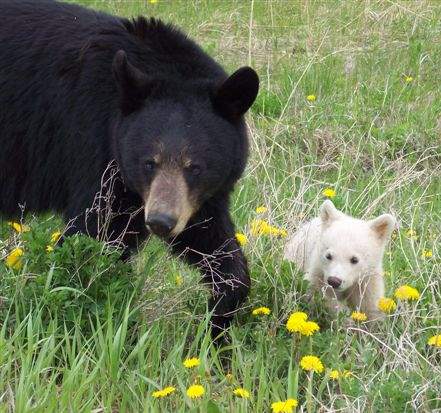I have been thoroughly enjoying a conversation on the Wisconsin Bird network online list. The chatter just now includes quite a bit about leucistic birds in Wisconsin… apparently it all started when someone reported a leucistic pileated woodpecker that returns annually to the same area. This fellow, while mostly white, retains its red crest!

Every so rarely a genetic WHITE PHASE appears in animals that are normally not white (except as albinos). But leucistic birds (deer, bear, moose!) are not albinos, and they can have s matters of white and smatterings of more colored feather, fur, or skin.
Albinism is a condition in which there is an absence of melanin. Melanin is what is present in the skin and is what gives skin, feathers, hair and eyes their color. … Leucism is only a partial loss of pigmentation, which can make the animal have white or patchily colored skin, hair, or feathers
The pictures on this page show not albinos, but a “white phase” or leucistic variation of the various species. Unfortunately, things are never as easy as you think that they should be!
John, from Mercer, Wis., contacted a genetistic who added the following information:
The literature on albinism clearly states that there are different kinds of albinism, and that some albinos may show some color in their irises – often a light blue or gray. An animal can be a pure albino or a partial albino. The most critical factor in producing melanin, the organic pigment that produces most of the color seen in mammals and birds, is the presence of a special enzyme called tyrosinase – the “TYR” gene (google this for all sorts of technical treatises). If the TYR gene fails completely, an all-white, light-eyed albino animal will be born. However, the TYR gene can be altered in dozens of ways, producing other albino variations, such as albinos with light eyes but with some color on their fur.
What caught my attention in the conversation was a post from Maryland. She commented that most leucistic animals she hears about seem to come from Wisc., Minn, and the Northwest.
“Does anyone know why that is?” she queried. Numerous learned responses indicate that it is entirely genetic, and not more common in the North.
That got me thinking about some of theories that abounded about birds, white buffalo, deer, and other such white or “Spirit Creatures” in the early 2000s.
Then, popular theory seemed pretty settled that these “white phase” or “Spirit” creatures are expressing recessive genes that helped to protect the species during the ice ages. I saw data which I didn’t save which demonstrated how quickly dark mammals would turn white as the dark animals turned into prey and those with a recessive white gene began to multiply.
In Wisconsin, a northern game warden told me that in his life time, he’s heard of two white phase bear cubs… both in the vicinity of Superior, Wisconsin. Hmmm… makes sense. The same game warden has seen only one white phase sparrow… nearly 40 years ago. I saw a white English sparrow in our yard a few year ago.
I wonder if the white phases of various birds of prey are also expressing recessive genes related to living along the edge of glaciers? I’ve also heard of Mississippi River islands with concentrations of white phase muskrats, and white phase deer I’d love it if you could share photos of your “white phase” creatures for use in a future feature article.

Above is a very rare “white” black bear cub photographed in the west. Also known as Kermode or “spirit” bears. Normally found only in areas where the recessive white gene was encouraged by small populations cut off from the larger populations, probably by glacier formations. The white gene would have been advantageous to bears living on the edge of the snowfields.
